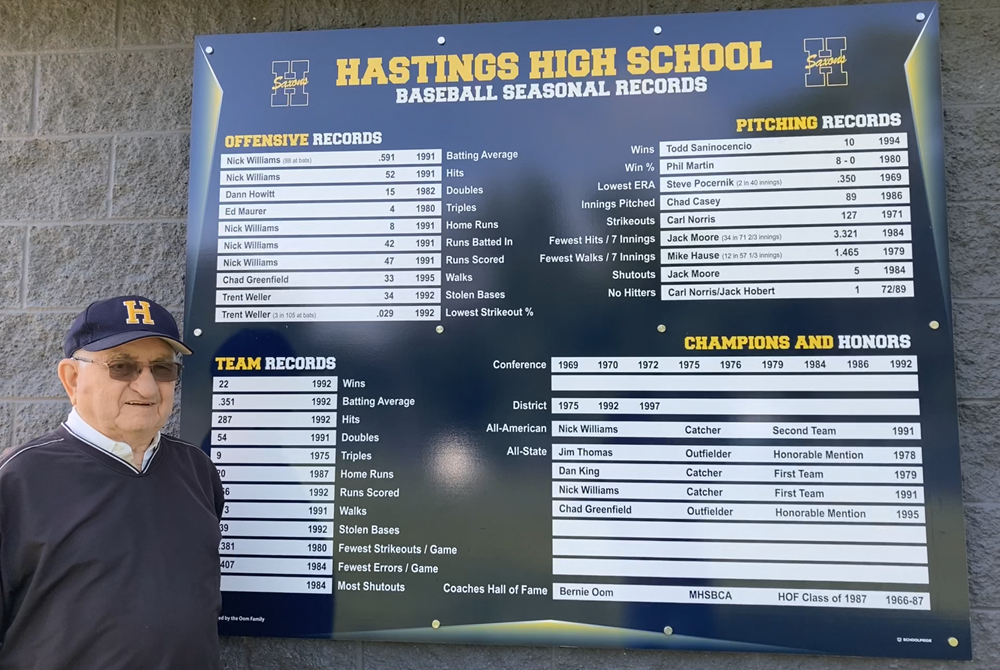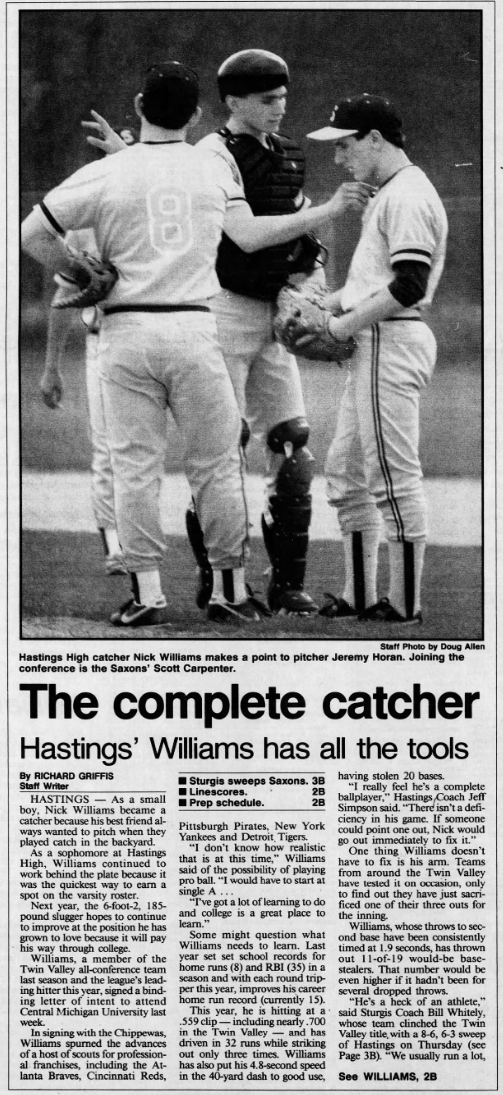
Add, Subtract, Divide, Multiply: MHSAA Not Alone
July 25, 2017
By Rob Kaminski
MHSAA benchmarks editor
This is the third part in a series on MHSAA tournament classification, past and present, that will be published over the next two weeks. This series originally ran in this spring's edition of MHSAA benchmarks.
As the MHSAA faces its most recent classification task with 8-Player Football, and opinions continue to swirl about as to the method, timeframe, location and other procedures, a look around the country provides plenty of company among state association brethren factoring variables into their own equations.
In the Pacific Northwest, the Oregon School Activities Association Football Playoffs are under public scrutiny as leadership ponders a five or six classification format beginning with the 2018-19 school year.
The OSAA has crowned six champions on the gridiron since 2006-07. Many of the state’s smaller schools would like to keep it that way, while larger schools lean toward a five-classification system, citing larger leagues, ease of travel and credibility to state championships as the advantages.
Still others would prefer more than six classes, pointing to safety issues and the opportunity to increase participation numbers as positives.
Moving southeast of Oregon, the Nevada Interscholastic Activities Association recently voted to hold serve on a classification proposal that was volleyed to the membership.
However, changes still could be forthcoming by as early as the 2018-19 season which would add a fifth classification in more populated southern Nevada while allowing northern schools to participate in four classifications. Such divisions could mean no state championship for the fifth class in southern Nevada.
Because of that, the NIAA wants equal numbers of schools in each classification on both ends of the state. Complicating the issue is the fact that the 24 largest schools in the state, by enrollment, are all in Clark County in Southern Nevada.
Across Nevada’s border into Arizona, charter schools are asking the Arizona Interscholastic Association to reconsider classification that was voted upon and approved in September 2015. That agreement called for the largest 33 percent of charter schools by enrollment to be placed in the state’s largest school classification, 3A, the middle 33 percent into 2A, and the smallest 33 percent into 1A.
Less than two years later the charter schools have had a change of heart and have asked to be considered the same as other Arizona public schools and be placed appropriately by enrollment beginning with the 2018-19 school year.
The situation in Arizona further illustrates how the public/private debate that all state associations have faced throughout existence now has the added dynamic of rapidly growing charter schools in today’s educational system, along with virtual school enrollment.
In the nation’s heartland, Nebraska has retooled its football classifications by using enrollment of boys students only in its schools rather than total enrollment. The Nebraska School Activities Association football-playing schools will kick off the 2018 season using this alignment.
Nebraska has three classes of 11-player football, with the smallest class divided in two, Class C-1 and C-2. The state also will have 8-player football for boys enrollments under 47, and the NSAA will sponsor a new 6-player tournament in 2018 for schools with 27 or fewer boys.
“This is a good proposal because some schools have a sizable imbalance between the number of boys and girls, and there’s a large gap (in enrollment) between the largest and smallest schools in Classes A and B,” NSAA executive director Jim Tenopir said. “I think this addresses both of those concerns.”
Swimmers in Georgia, meanwhile, will feel like they are moving with the current, rather than upstream in 2017-18, as the Georgia High School Association recently doubled the number of team championship events from two to four.
Swim enthusiasts can also count on longer days at the finals, as the top 30 finishers from the prelims will advance to the finals instead of 20, and all championship events will have three heats versus two.

Record Board Celebrates Hastings Record-Setters Over 7 Decades on Diamond
By
Steve Vedder
Special for MHSAA.com
May 29, 2024
Bernie Oom had no intention of letting the past slide into history.
 So the 88-year-old retired longtime Hastings baseball coach embarked on a meticulous two-year labor-of-love project that recognized the Saxons’ record-breaking ballplayers from the last five decades.
So the 88-year-old retired longtime Hastings baseball coach embarked on a meticulous two-year labor-of-love project that recognized the Saxons’ record-breaking ballplayers from the last five decades.
The result is an impressive 63-by-52-inch record board attached to the baseball field's press box located directly behind home plate. The board chronicles a myriad of individual pitching, hitting and team marks derived from Oom's 22 years as coach as well as statistics from his six successors.
Included are records from the top players in Hastings history, including a former Saxon who collected the last hit off hall-of-famer Nolan Ryan, a slugging catcher who was drafted by Seattle and Cincinnati and spent time in the Boston organization, and a Hastings pitcher who owns the oldest mark when he fashioned a 0.35 ERA with just two runs allowed in 40 innings in 1969.
Oom, a member of the Michigan High School Baseball Coaches Association (MHSBCA) Hall of Fame, always kept close track of statistics and records as a coach. Two years ago when his son Wayne began a similar project with the Hastings track program, Oom thought it was time for his former diamond stars to be recognized. While a handful of schools may post scattered records in gymnasiums, it's extremely rare for a school to post records at a baseball field.
"I always liked statistics, and I decided I wanted to keep that kind of stuff up. I'm kind of a stickler for remembering things; details are important to me," said Oom, who compiled a 272-188 record with eight West Central and Twin Valley titles as coach from 1966-87.
"I talked to a lot of my old players, and they thought this was a great idea. But part of the real value is having a ninth grader looking at this and saying, 'I see this, and I want to be up there some day.' I think it will spur things in the program."
In collecting info for the board, Oom went through his 22 seasons of statistics and records, then contacted the six coaches who followed him, including one, Jeff Simpson, who now lives in Arizona. Oom and his son visited local schools such as Grandville and Grand Rapids South Christian for ideas and decided to work with a company called School Pride out of Columbus, Ohio, to produce the board. Oom and the company took two years to get it right, Oom said.
The result are 12 team, 10 offensive and nine individual pitching records as well as a list of the program's all-staters noted on the board.
 Point to any records and the still razor-sharp Oom will have a story about the player or the team that produced the mark. Among them is the 15 doubles clubbed by star Dann Howitt in 1982. Howitt, who played 115 major league games across six seasons with six clubs, has a unique claim to fame as the last player to collect a hit of Nolan Ryan on Sept. 22, 1993. A 46-year-old Ryan, who finished with 324 wins and 5,734 strikeouts, walked the bases loaded against the Seattle Mariners, bringing up Howitt, who promptly drove a Ryan fastball over the left field fence. Ryan, a right-hander, tore a right elbow ligament pitching to the next hitter and exited the game, never to pitch again.
Point to any records and the still razor-sharp Oom will have a story about the player or the team that produced the mark. Among them is the 15 doubles clubbed by star Dann Howitt in 1982. Howitt, who played 115 major league games across six seasons with six clubs, has a unique claim to fame as the last player to collect a hit of Nolan Ryan on Sept. 22, 1993. A 46-year-old Ryan, who finished with 324 wins and 5,734 strikeouts, walked the bases loaded against the Seattle Mariners, bringing up Howitt, who promptly drove a Ryan fastball over the left field fence. Ryan, a right-hander, tore a right elbow ligament pitching to the next hitter and exited the game, never to pitch again.
Oom remembers Howitt more as a line-drive hitter than a power threat. He actually hit more homers as a major leaguer (five) than he did as a Saxon (one in 120 at-bats over two seasons). The doubles record is the only time Howitt appears on the board, despite batting a combined .392 as a junior and senior.
"Teams would pitch around Dann," Oom said of Howitt, whose other claim to fame is backing up stars Mark McGwire, Tino Martinez and Frank Thomas at the major league level.
Among the other records are indicators of arguably the greatest season ever produced by a Hastings hitter. Nick Williams owns program records for batting average (.591), hits (52), homers (8), RBIs (42) and runs (47) all set in 1991. Williams said among his sharpest memories from that spring is struggling through his only hitless game of the season. He went 0-for-3 in the finale to drop below .600 for the only time all spring. At the time, no Michigan high schooler had batted .600 for one season.
"The ball looked big to me all year," said Williams, who was drafted out of high school by the Mariners, out of Central Michigan by the Reds after his junior season and eventually signed with the Red Sox as a free agent. "I had a pretty good high school career, and I was pretty confident as a senior. I had put a lot of work in hitting on a tee in our garage. Then I would play ball all summer. I improved steadily, and I saw the results that summer."
Former Saxons pitcher Steve Pocernik holds the oldest mark on the board after surrendering a meager two runs in 40 innings for a 0.35 ERA in 1969. After 55 years, Pocernik isn't completely sure but thinks the runs came in one game against St. Johns.
"I didn't throw hard, but I had a curve and I could put the ball where I wanted," he said. "(The record) kind of took me by surprise. I think it's super that Bernie had done what he's done. It's a nice thing for the guys who played for him."
Does keeping the record for five and a half decades come as a surprise? Kind of, Pocernik said.
"Yes and no," he said. "Yes in that it's been a lot of years. No because I don't think pitchers today pitch like we did. There are a lot of guys who've come after me."
Another of the Hastings pitching marks is the tiny total of 12 walks in 57 innings by Mike Hause in 1979. That's an average of just 1.4 walks over seven innings. Like Pocernik, Hause said he didn't throw hard. He mixed a curve with a fastball that rode in on righthanded hitters. Speed aside, Hause explains the low number of walks with having a definitive plan as a pitcher. He remembers focusing on throwing first-pitch strikes and then keeping hitters off-balance with an occasional knuckleball.
"I would work on hitting my spot even in the preseason in the gym," he said. "We put up a strike zone mat with holes in it, and I would try to throw the ball through that spot. I didn't throw as hard as some guys, but I threw strikes."
PHOTOS (Top) Retired Hastings baseball coach Bernie Oom stands with the record board he’s created that is displayed at the school’s diamond. (Middle) A Battle Creek Enquirer story from 1991 discusses Nick Williams' accomplishments. (Photo by Steve Vedder.)

